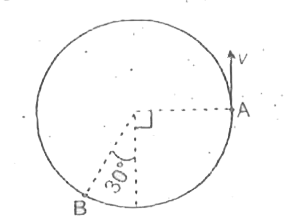A stone of mass 'm' is rotated in a circular path with a uniform speed by tying a string with the help of your hand. Answer the following questions :
What kind of force acts on the hand and state its direction?
To solve the question regarding the force acting on the hand when a stone is rotated in a circular path, we can follow these steps:
1. Understanding Circular Motion: When an object, such as a stone, is rotated in a circular path, it experiences a force that keeps it moving in that circular path. This force is known as the centripetal force.
2. Identifying the Forces: In this scenario, the stone is tied to a string, and as it rotates, it exerts an outward force on the string due to its inertia. This is often referred to as the centrifugal force, which is not a real force but rather a perceived effect due to the inertia of the stone.
3. Effect on the Hand: The hand, holding the string, experiences a reaction to the centrifugal force exerted by the stone. According to Newton's third law of motion, for every action, there is an equal and opposite reaction. Therefore, the hand feels a force pulling it outward.
4. Direction of the Force: The direction of the force acting on the hand is radially outward, away from the center of the circular path. This means that while the stone is being pulled towards the center by the tension in the string (centripetal force), the hand feels a force acting outward due to the stone's inertia.
5. Conclusion: The force acting on the hand is the centrifugal force, and its direction is radially outward from the center of the circular motion.
Final Answer:
The kind of force acting on the hand is the centrifugal force, and its direction is radially outward.
The kind of force acting on the hand is the centrifugal force, and its direction is radially outward.
Topper's Solved these Questions
Similar Questions
A piece of stone tied at the end of a thread is whirled in a horizontal circle with uniform speed by hand, Answer the following questions
(a) Is the velocity of stone uniform or variable?
(b ) Is the acceleration of stone uniform or variable?
( c) What is the direction of acceleration of stone at any instant?
(d) which force provides the centripetal force required for circular motion?
(e) Name the force and its direction which acts on the hand.
View SolutionA car of mass 1000 kg moves on a circular path with constant speed of 16 m/s. It is turned by 90º after travelling 628 m on the road. The centripetal force acting on the car is-
View SolutionA particle of mass m is rotating in a plane in circular path of radius r. Its angular momentum is L. The centripetal force acting on the particle is
View SolutionA particle of mass M moves with constant speed along a circular path of radius r under the action of a force F. Its speed is
View SolutionWe know that when two equal masses are placed on a line then, gravitational force on a third mass is zero due to these two masses when the third is placed at the centre of line joining the two masses. But if third mass is placed anywhere else on the x-axis, the gravitational force acts on that mass due to these two masses. Consider a system shown in figure.

In this system two point masses of mass M each are placed at y-axis at a distance a from origin and these masses are fixed. If a third point mass of mass m is released at a distance x from origin on x-axis, then answer the following questions.
If a >> x, then which of the following statements is correct about the motion of mass m ?
View SolutionA Particle of mass 'M' moves in a uniform circular path of radius 'r' with a constant speed 'v' then its centripetal acceleration is .
View SolutionA car of mass 1000 kg is moving with a speed of 40ms−1 on a circular path of radius 400m. If its speed is increasing at the rate of 3ms−2 the total force acting on the car is
View SolutionA particle of mass m moves with constant speed v on a circular path of radius r as shown in figure. The average force on it during its motion from A to B is

View SolutionA particle of mass 1 kg moves in a circular path of radius 1 m such that its speed varies with time as per equation v=3t2m/s where time t is in seconds. The power delivered by the force acting on the paritcle at t=1s, is :−
View SolutionA large mass M and a small mass m hang at the two ends of string that passes through a smooth tube as shown in fig. The mass m moves around in a circular path which lies in a horizantal plane. The length of the string from the mass m to the top of the tube is of length l and θ is the angle this length makes with the vertical, what should be the frequency of rotation of the mass m so that M remains stationary if M=16kg,m=4kg,l=1m and g=π2m/s2

View Solution
